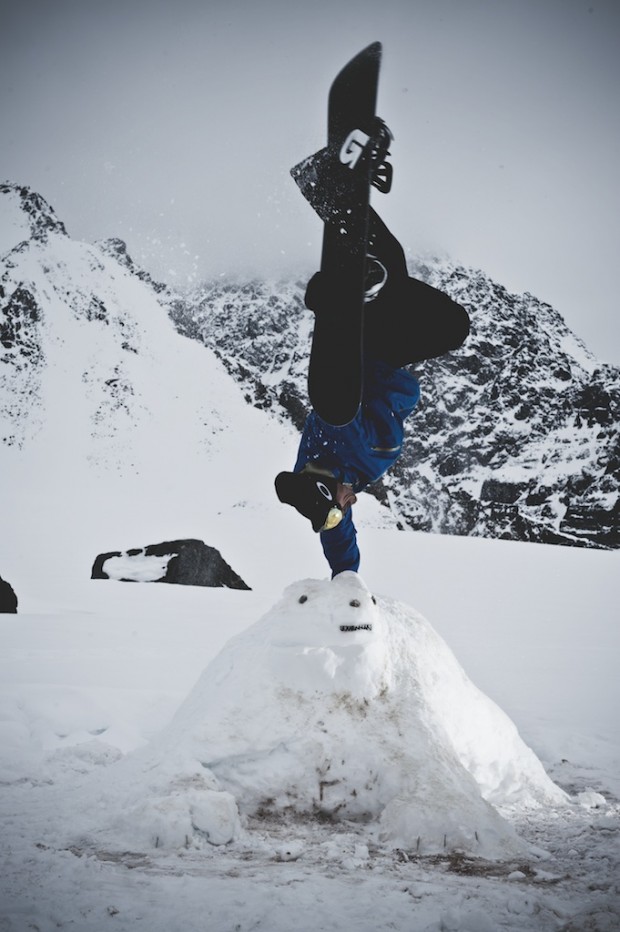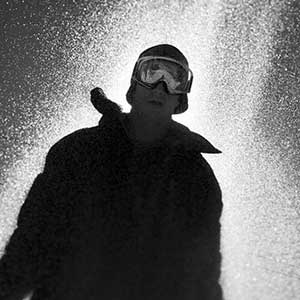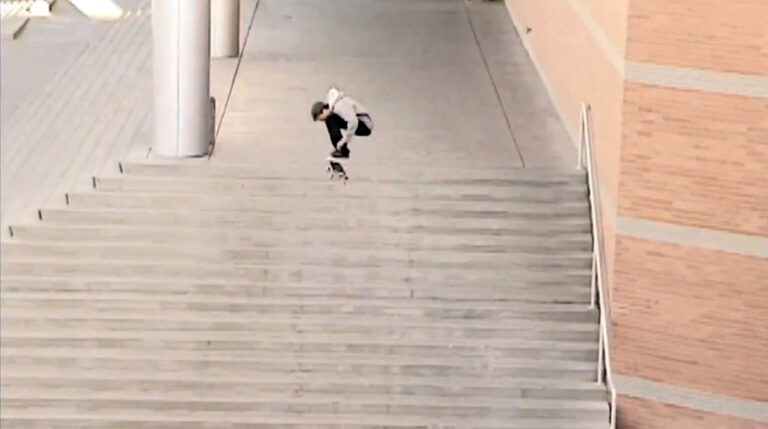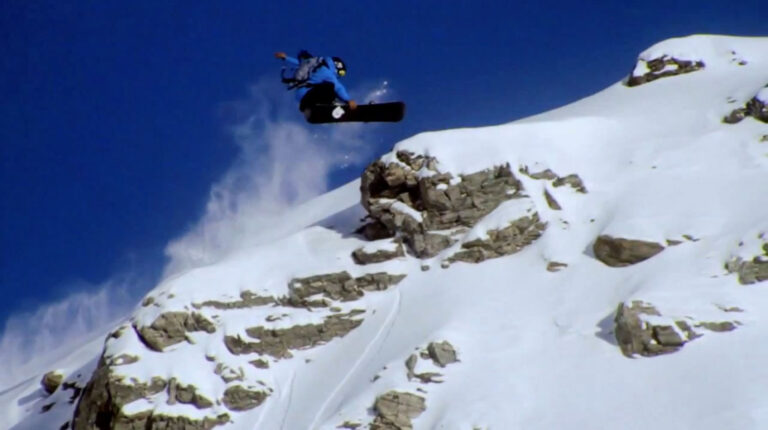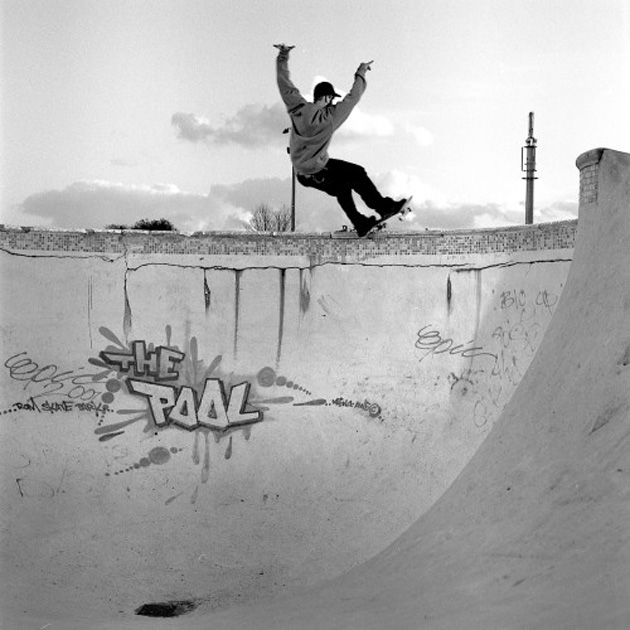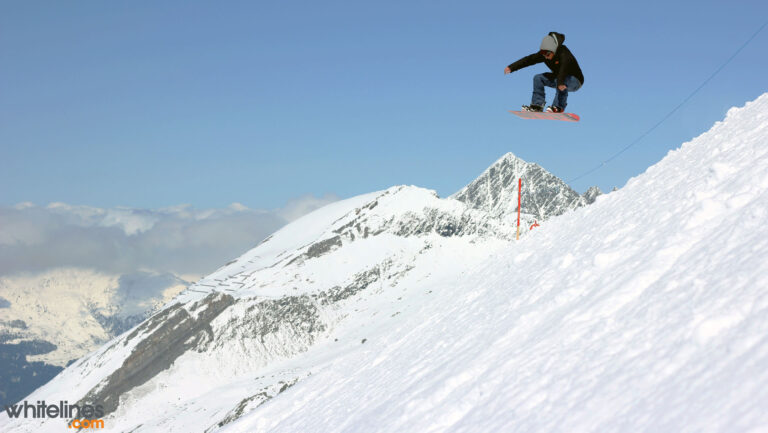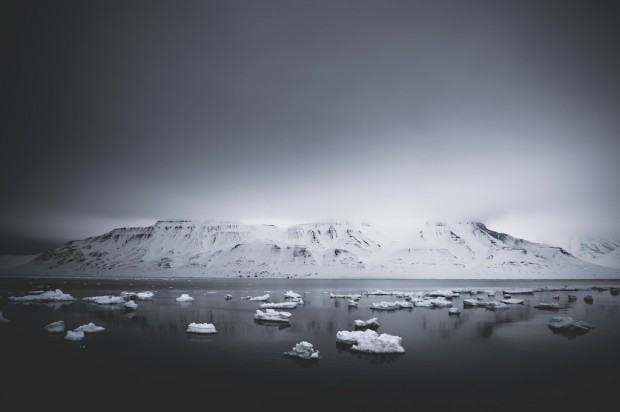
The Svalbard Discovery
Jeremy Jones is embarking on a new two-year film project that promises to take freeriding ‘Further’. Photographer Dan Milner joined him beyond the Arctic Circle for a journey into the snowboarding unknown.
“We don’t want to – and it’s not ideal – but we will have to camp here,” announces Anden, our lead guide.
‘Not ideal’ seems to be local slang for ‘might get eaten’. The frozen sea ice of the fjord on which we’re stopped is a very active polar bear feeding zone, and only a mile earlier we’d pulled up to examine frying-pan sized bear tracks on the ice. I put my hand into one paw print, the enormity of the impression making my normally man-sized hand look instantly like a child’s. “It’s not ideal,” I repeat in my head, pondering what lies ahead of us.
In truth I’m almost beyond caring. It’s 6 a.m. and we have been snowmobiling for ten hours, through a night filled with daylight, snowstorms and fog. Now, only seven miles from our destination, we’re blocked by an impassable mix of knee-deep slush, shiny blue ice and raging glacial meltwater torrents. Our touring sleds, even without the trailers laden with camping gear, will get nowhere, and although he tries to hide it, Anden is visibly fatigued from the numerous vehicle rescues he’s already performed. When Jeremy Jones decided to call his new splitboard film ‘Further’ he wasn’t joking.
“We have to wait tomorrow and see if it gets colder,” adds Anden. “Then we might be able to make it up the glacier.” I reach into one gear trailer to pull out a tent, and begin erecting it as a cold rain starts to fall. Ahead of me is probably the most fitful five hours of ‘sleep’ I’ll ever have.
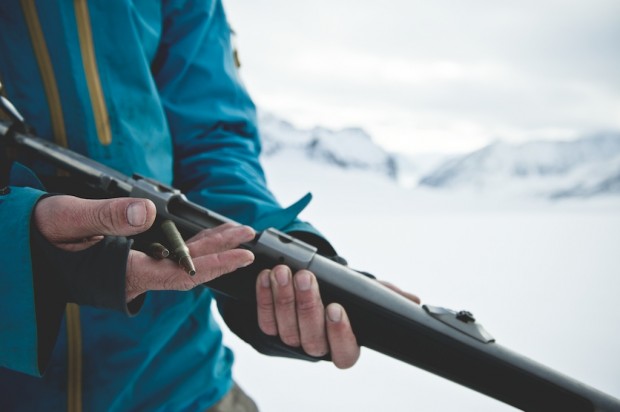
Accompanying Jones on this first film trip is the snowboarding legend Terje Haakonsen. Our destination is Svalbard, a cluster of Norwegian islands only 700 miles from the North Pole. Open up any airline’s in-flight magazine and the islands are so far north that they’re cropped from the top of the route map. They represent the most northern rideable terrain in the world, aside from jibbing icebergs on the polar ice cap. Svalbard’s mountains are steep, its weather unpredictable and its wildlife unforgiving. It doesn’t sound a welcoming place, but as I’m learning, it’s exactly these kind of credentials that lure Mr. Jeremy Jones. When it comes to ‘further’, Svalbard ticks all the adventure boxes. But just a day in, our Deeper AK camp-out two years ago [WL87] seems a beach party in comparison. And we have fourteen more to go.
The islands of Svalbard are so far north that they’re cropped from the top of the in-flight route map
I’d be lying if I said that the whole of Svalbard was inaccessible. A population of 2000 (mainly Russian coal miners and international students) ensures there is a daily flight connection to the outside world. We fly into Longyearbyen, the only real community on the islands (aside from remote polar research huts occupied by bearded fellows with personal hygiene issues), our plane skimming low over the iceberg-choked fjord. It’s late April and we arrive to a blizzard.
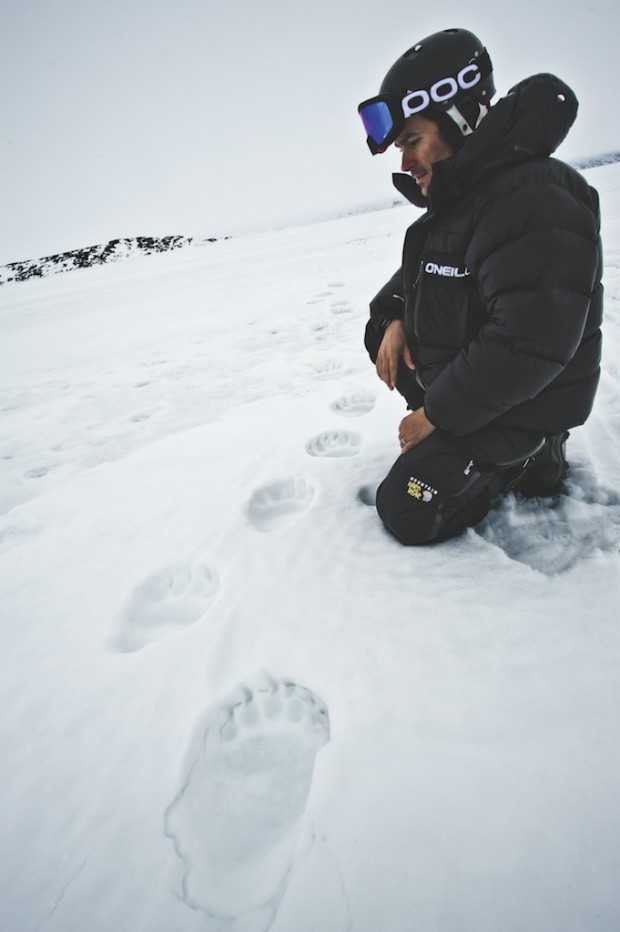
“It’s not a problem,” says Anden, our Norwegian guide from local logistic experts Pole Positions. “We just have to go slower and it takes more time.” He’s referring to the snowmobile trek out to the Atomfjella area, and our chosen camp zone nestled on a glacier between the island’s two highest peaks, Newtontoppen and Perriertoppen, which stand at 1700m. Anden is tall, slim and a man of few words. He is at home in the Arctic, a Svalbard resident for five years, and his “not a problem” approach is something we’ll appreciate during the next 25 hours – the time it takes us to complete the 100 mile sled journey. Our trek, aboard five snowmobiles towing almost a ton of camping and safety gear, leads us across frozen fjords, up and over rolling glaciers and past the broken, serac-spewing faces of enormous tongues of ice. It’s dramatic and it’s cold, but not as cold as we’d like. The advent of spring has wreaked havoc with the pack ice, and as we motor over the frozen wilderness we become repeatedly bogged down in pools of melted ice with the consistency of Slush Puppies. By the time we reach our first night’s “not ideal” camp spot we’re fighting the chill of sodden feet and braving the mental challenge of a cold, incessant rain. No-one expected rain.
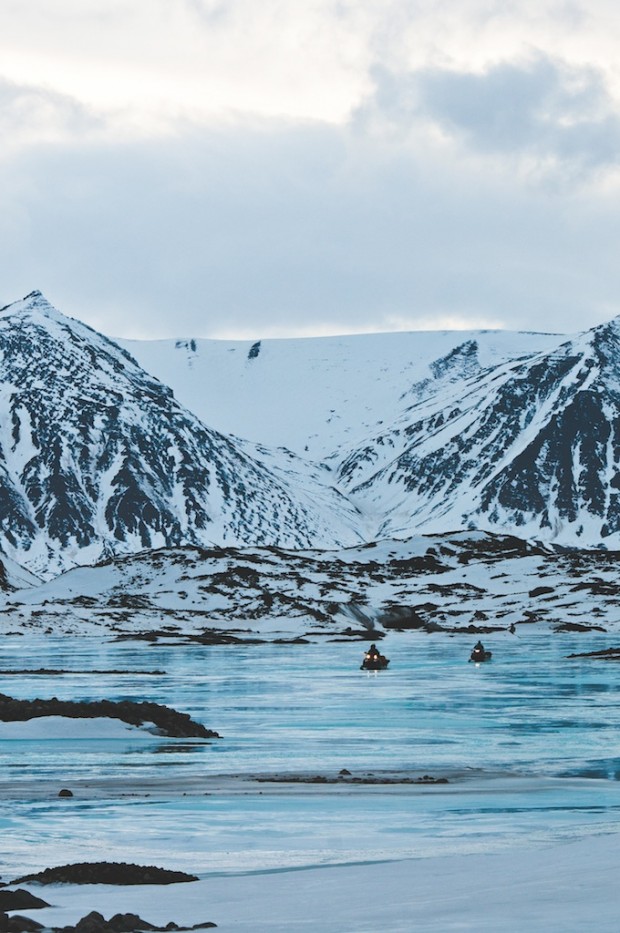
Anden’s positive tone brings a change of luck, however. During our five-hours of fitful sleep the temperature drops sufficiently to refreeze some of the way ahead, and while sleet replaces drizzle we manage to navigate the sleds up onto the glacier. Luck is a relative term of course; it still takes a whole seven hours to cover just 10 miles, stopping every few hundred yards to shovel snow over rocks and form our own ‘road’ for the heavily-loaded machines. The zone Jones has in mind consists of flat, easy going glaciers punctuated by near vertical walls. Back in Longyearbyen we’d studied topographic maps of the area, but when we finally silence the sleds at basecamp, nothing prepares us for the view ahead. All around sit sharp spikes of rock, as dramatic as any Chamonix or the Tetons can muster, and slicing down their sheer faces are ribbons of snow – tight couloirs that drop 50 degrees from top to bottom, each representing 2000 feet of uninterrupted joy. We survey our adopted home and scan the mountain faces around us. Everywhere there is stuff to ride, and on every aspect, but each descent will have to be earned on foot.
Our trek leads us across frozen fjords, up and over rolling glaciers and past the broken, serac-spewing faces of enormous tones of ice
We’ve come in on the heels of the midnight sun, giving us 24/7 daylight to work with. Already our sleep patterns are out of kilter, our watches irrelevant. While the extra sled drivers turn around and head off, leaving us with only one vehicle for safety, we pitch camp. Our attention is continually drawn to the enormous headwall that closes off the blind valley behind us, and the huge off-camber ramp of snow that cuts a diagonal line across its face. North facing and shady when we arrive, we see the ramp slowly become bathed in orange light as we boil water for a midnight freeze-dried dinner. At 78 degrees north, the sun may stay low in the sky but it does throw direct light onto the north aspects, something we can never shoot in more southern latitudes. We look at each other over steaming foil sachets, sharing the realisation that our snowboarding schedule just took the night shift. It’s 1 a.m.
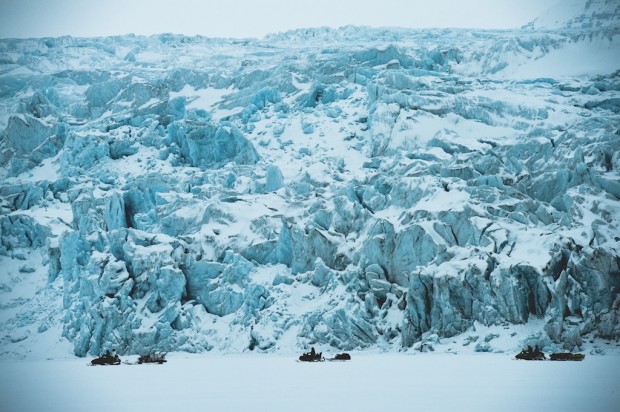
The mild spell of weather has left a rain crust on the snow, even up around the camp at 1200m. We head out on the splitboards, skinning around our new neighbourhood and increasingly excited by the possibilities. Jones is a simmering pan of excitement. Returning from our first reccie, we arrive back at camp to find it encompassed by a 2-foot high tripwire. ‘”Hey guys, watch the bear fence,” shouts Gigi, our second guide, before explaining how the wire sets off charges at each corner when tripped, scaring the bear – or at least giving you time to grab the gun. “In theory, at least,” he adds, “often they don’t work.” Indeed, only 10 weeks after our trip a young British student is mauled to death on the island, their trip wire not having tripped. Luckily Gigi, a 20-something Austrian guide who has found love and new beginnings in Svalbard, is a master at setting the fence charges. The proof comes during the next two weeks, when the fence is tripped repeatedly by members of our group stumbling from their tents to answer the call of nature. We learn that nothing can rouse you from your slumber more rudely than a polar bear fence being tripped.
At 78 degrees north, the sun throws direct light onto the north aspects, something we can never shoot in more southern latitudes
Our initial bursts of enthusiasm send us energetically skinning across the glacier to climb some of the lower couloirs, but our efforts are poorly rewarded with scratchy lines down crusty chutes. At dinner, frustration is painted on everyone’s faces. We wake on day four to the sound of a thousand needles dancing on the tent fly: snow. The weather in Svalbard is fickle at the best of times, and despite its polar location snow doesn’t fall in any great quantities here. We watch patiently as the fresh slowly accumulates around camp, biding three days in the group tent, where we play unnecessarily complicated card games and discuss the world we live in. With no mobile reception, no TV and no Facebook updates, we turn instead to the art of real communication, face to face, slowly realizing that it is this kind of human interaction – as much as the snowboarding itself – that makes such trips special. This, says Jones, is the lifeblood of Further. He’s setting out to make a film that shows, by example, that real life isn’t about high tech voyeurism; it’s about getting back to the basics, about reclaiming the fundamentals, about not losing touch with your surroundings. Further is unlikely to be played on a PS2.
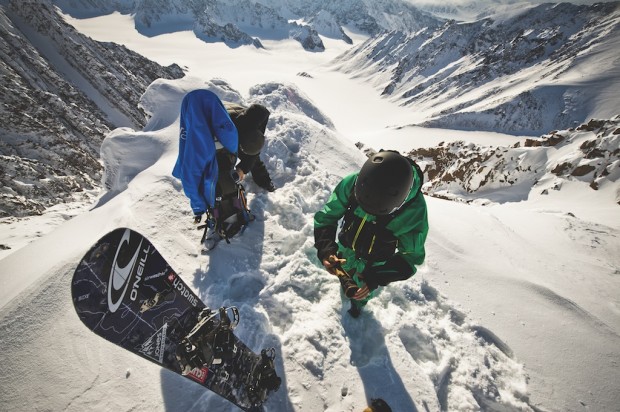
Temperatures rise and fall – good signs for the snow adhering to the faces ¬– and the 6 inches that land on the camp is driven two foot deep into the couloirs by a fierce Arctic wind. After 72 hours the storm breaks and a high pressure rolls in, bringing sunshine and finger-numbing temperatures. We’re quick off the mark, heading into a zone we’ve already scoped out and which offers a few more forgiving descents, with less consequences should something rip out. It’s a good call, as Terje’s second line slices the whole chute out from under him, sending a 40-foot high airborne avalanche racing to the bottom. We watch and shoot in awe from across the cirque, zippered up and battling a -25C windchill.
As the snowpack gradually bonds more firmly, Jones and Terje take on more demanding couloirs, skinning in, climbing up and ripping their lines like an enormous game of snakes and ladders. From a rime-blasted summit we peer across to one of the most dramatic mountainscapes I have ever seen: a 2500 foot tongue of snow, consistently forty foot wide, which spears its way down between two shoulders of rock. It’s like a bolt of white lightning against the dark crags. We tag the chute “Nat Geo”, due to the anticipated shot being worthy of a National Geographic cover, so beautiful is the play of light on this astonishing landscape. Jones slays the entire couloir, top to bottom, in six powerful turns. “This is unreal,” he says, when we next regroup. “To get a perfect 50 degrees, with such mellow open run outs.”
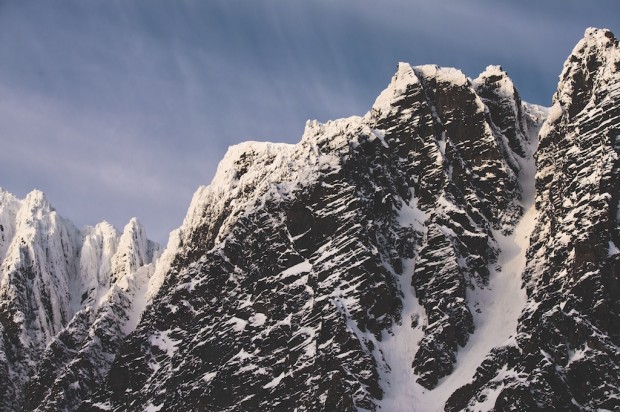
Shooting on-slope rewards the filmers and I for our own pack-lugging splitboard efforts, with runs to the bottom of some wild, AK-style pitches, while Gigi highlights his own mountain-upbringing by following Jones and Terje down some of the most demanding lines. The Austrian is not shy of a little airtime it turns out.
We work every aspect, feeling genuinely like kids in a sweet shop, not sure which bounty to turn our attention to next. Terje ticks off the mini chutes immediately behind camp, throwing some huge backside airs off every lip on the way down, and each morning at 4 a.m. we finally collapse into the mess tent to consume dinner. Sleep will be until midday.
We watch Jones drop into the face, straightlining the initial 50 degree chimney and into a set of rooster tailing turns and mach ten airs. He covers the entire 2,400ft face in under 30 seconds
Far from making things easier, however, the 24/7 daylight brings us a strange dilemma. Do we store our energies for the magical light of the midnight session, or nail the western flanks earlier in the day? We have too many options. Wherever we head, we’re escorted by Gigi, who carries a powerful 0.33 rifle and flare gun. The gun toting is a legal requirement everywhere on the islands outside of town, and although it’s rare to find polar bears so far up on the glaciers, if they are hungry enough they will come, lured perhaps by the noisy population of Auks nesting on the cliffs nearby. In Svalbard, every sled has a gun rack.
Slowly, over three days, each of the couloirs in our zone is ticked off, our crew regularly returning to camp after a 15 hour session. Each face we hit requires a full hour to approach on the splitboards, and a two to three hour climb up to the summit. The absence of darkness helps fuel our energies, keeping our internal engines running until finally, having returned to basecamp, the brain decides it’s time to sleep. Our daily routine starts to last longer than 24 hours.
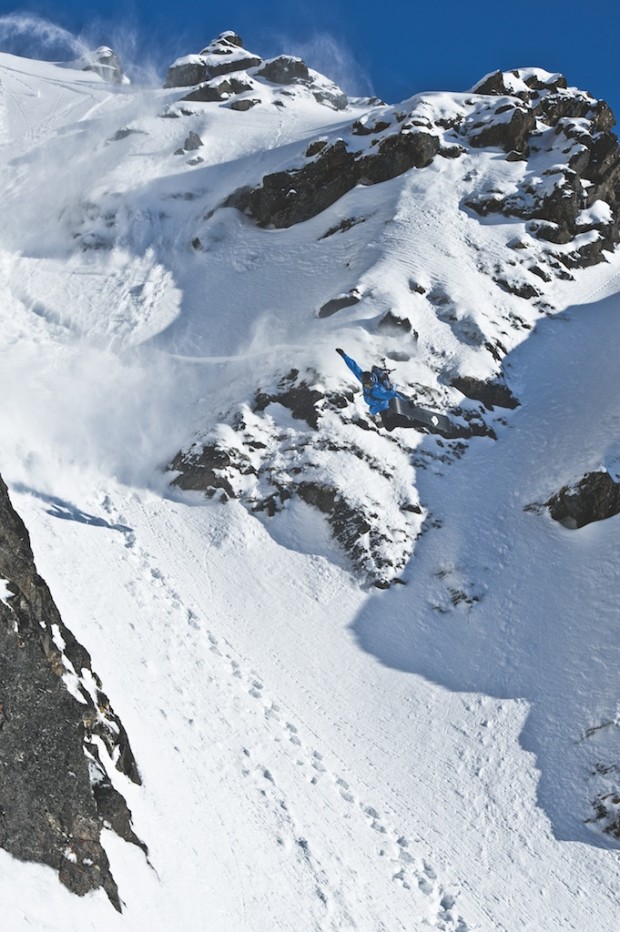
Several times we race for lines only to miss the light by minutes, while others come easy. Then, after 12 days out, Jeremy decides it’s time:
”You see it, Dan?” he says, looking back behind our basecamp at the enormous headwall. The problem is that I can see any number of lines back there that would have Jeremy popping his load. “The ‘camp ramp’, the whole reason for placing camp here,” he says, a little agitated at my lack of couloir filtering. He is of course looking at the enormous shelf that dwarfs the camp – the vast, steep and exposed 45 to 50 degree face that offers little room for error. “I think it’s ready.”
The scale of Svalbard’s terrain throws us yet again. It takes 90 minutes to skin to the base of the Camp Ramp, and a further 150 for Jones, Terje and TGR filmer Dan Gibbeau to climb its vertiginous face. Accompanied by the other two filmers, Chris and JK, I crampon up the opposite face to get a vantage point – the ‘barbie’ angle as it’s called in the trade, as it’s usually the easy, sweat-free angle to shoot from. Crampons and ice-axes though, are not what I call BBQ attire. As the face becomes bathed in an ephemeral pink glow, we watch Jones drop into the face, straightlining the initial 50 degree chimney and into a set of rooster tailing turns and mach ten airs. From our vantage point the line looks almost lazy, but he covers the entire 2400 ft face in under 30 seconds. Terje drops in next and repeats the show, working the Western edge of the ramp, before being spat out at its base at warp speed.
Terje’s second line slices the whole chute out from under him, sending a 40-foot high airborne avalanche racing to the bottom
I lower my camera and remember to breathe again, glancing at Gigi and my fellow grinning cameramen. Behind us the sun is slipping its way east. It’s 3 a.m. and I know in three hours dawn will break back home across mainland Europe. Immersed in radiant Arctic light, I stoop to remove my crampons and pack my gear for the ride back to camp. To my left sits a virgin face, perfect and powder laden. Our run will be a good one. High on a ridge, about to drop into a line in one of the most remote corners of the world, for once I couldn’t care less about polar bears.
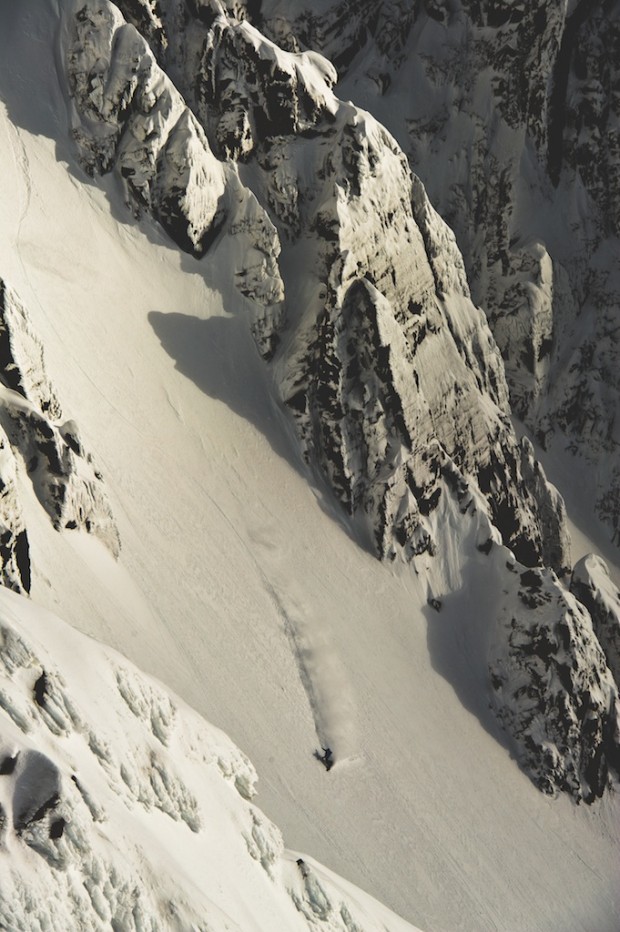
Ursus maritimus
Svalbard and the Russian Franz Joseph Land (joined by sea ice in winter) share the highest concentration of polar bears in the world, numbering some 3000. The Polar Bear (//Ursus maritimus//) is the largest terrestrial predator, typically weighing between 350 and 550 kilos (yes, that’s half a ton!) They inhabit the arctic regions of Alaska, Canada, Russia, Norway and Greenland. Their primary source of food is the ringed seal, which they can smell beneath the sea ice from over a mile away, catching them when they surface through breathing holes. The polar bear paw is 12 inches in diameter and each claw 2 inches long. Equipped with a 4-inch thick layer of fat, and fur made up of insulating hollow-core hair, they are perfectly adapted for Arctic survival. They can run at 25 mph.
Polar bears rely on sea ice for their survival, which grants them access to their prey. In summer, when the sea ice breaks up and drifts further from shore, they will try to stay with the ice, but for those stranded on land feeding becomes more difficult and it is common for polar bears to go long periods without eating. It’s at this time in the autumn, when they’re at their hungriest, that they can become most dangerous to humans, as evidenced by the student death in Svalbard last August. With climate change affecting sea ice in the Svalbard archipelago and other Arctic regions, encounters with stressed polar bears will likely become more common as they venture inland to find food.
Learn more about polar bears and what you can do to help them at www.polarbearsinternational.org
